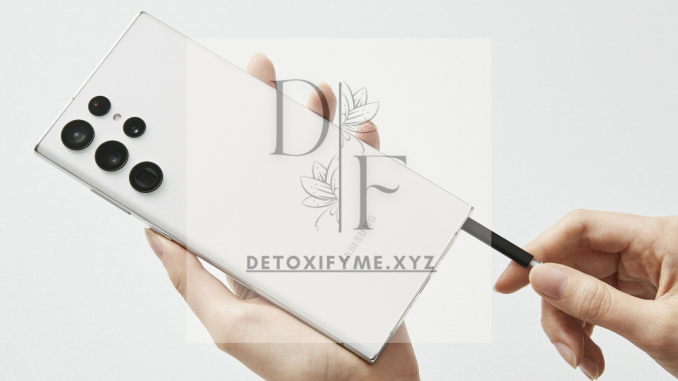
The touchscreen stylus pen has revolutionized the way we interact with our digital devices. From creative professionals sketching on tablets to students taking notes on their smartphones, a stylus pen offers precision, control, and a natural feel that enhances digital experiences. As devices like tablets, smartphones, and touch-screen laptops become more integral to daily tasks, a high-quality stylus pen provides increased functionality and comfort for users across various applications. This article explores the benefits, features, and types of stylus pens, as well as tips for choosing the best stylus to enhance your productivity and creativity.
1. What is a Touchscreen Stylus Pen?
A touchscreen stylus pen is a tool designed for use on touch-sensitive screens, allowing users to interact with their devices more precisely than with their fingers. Stylus pens come in various shapes, sizes, and functionalities, from basic models to advanced versions with pressure sensitivity and tilt recognition. They work by mimicking the touch of a finger but provide more accuracy, making it easier to draw, write, or control actions on a screen.
a) Active vs. Passive Stylus Pens
There are two main types of stylus pens: active and passive (or capacitive).
- Active Stylus: Active stylus pens are equipped with additional features such as pressure sensitivity, tilt recognition, and sometimes an internal battery. They communicate directly with the device for increased precision, making them ideal for artists, designers, and professionals.
- Passive Stylus: Passive or capacitive stylus pens do not have built-in electronics and work by conducting the electrical charge from your hand to the touchscreen. While they lack advanced features, they are compatible with a wide range of devices and are budget-friendly.
2. Benefits of Using a Touchscreen Stylus Pen
A touchscreen stylus pen enhances the user experience in many ways, improving both productivity and creative potential. Here are some of the main benefits:
a) Improved Precision and Control
A stylus pen offers far greater accuracy than using fingers, allowing users to select small elements, control fine details, and achieve smoother lines. This precision is especially valuable for tasks that require accuracy, such as drawing, designing, and writing, where even slight movements can affect the outcome.
b) Enhanced Productivity for Professionals and Students
Stylus pens provide a more efficient method for taking notes, annotating documents, and managing tasks, making them ideal for professionals and students alike. With handwriting recognition and note-taking apps, users can write directly on the screen, convert handwritten notes into text, or mark up documents on the go. This increased productivity makes stylus pens popular in settings like business meetings, classrooms, and creative work environments.
c) Natural Drawing and Writing Feel
Stylus pens offer a writing and drawing experience that feels more natural than tapping on a screen with a finger. Many advanced stylus pens replicate the feel of traditional pens and pencils, making them ideal for artists and creatives who need a tool that allows for expressive lines, shading, and brush strokes. With features like tilt sensitivity and pressure sensitivity, high-quality stylus pens mimic the tactile feedback of traditional tools.
d) Reduced Smudges and Fingerprints on Screens
Using a stylus pen keeps your screen cleaner by minimizing direct contact with fingers, which can leave smudges, fingerprints, and oils on the screen. A cleaner screen improves visibility and extends the life of screen protectors, reducing maintenance and enhancing the overall appearance of your device.
e) Improved Accessibility and Ease of Use
For individuals with limited mobility or dexterity, a stylus pen provides a more accessible way to interact with digital devices. It enables precise control for tapping, swiping, and typing, making it easier to navigate apps, select items, and perform tasks with greater ease.
3. Key Features to Look for in a Touchscreen Stylus Pen
Choosing the right stylus pen involves considering several important features that affect usability, comfort, and functionality. Here’s what to look for when selecting a stylus pen:
a) Pressure Sensitivity Levels
Pressure sensitivity is a key feature in advanced stylus pens, especially for artists and designers. It allows the pen to respond to varying levels of pressure, creating different line thicknesses and intensities based on how hard you press. Common sensitivity levels range from 1,024 to over 4,096 levels, with higher numbers offering more control over detail and line work.
b) Tilt Recognition for Natural Shading
Tilt recognition enables the stylus to detect the angle at which it’s held, allowing for natural shading effects and varied brush strokes. This feature is valuable for digital artists who want to create lifelike drawings, as it replicates the experience of using pencils, brushes, or markers.
c) Palm Rejection Technology
Palm rejection technology allows users to rest their hand on the screen while using the stylus without causing accidental marks or screen movements. This feature enhances comfort and usability, especially during extended writing or drawing sessions, by preventing unintended inputs.
d) Battery Life and Charging Options
Active stylus pens often come with built-in batteries, so it’s important to consider battery life and charging options. Some models offer long battery life of up to several hours, while others require frequent recharging. Look for stylus pens with quick charging options or replaceable batteries, depending on your preference.
e) Compatibility with Your Device
Ensure that the stylus pen is compatible with your device model, as not all stylus pens work across every brand or device type. Many active stylus pens are designed specifically for certain devices, such as the Apple Pencil for iPads or the Samsung S Pen for Galaxy tablets. Capacitive stylus pens, on the other hand, are usually compatible with most touchscreen devices.
f) Customizable Buttons and Shortcuts
Some stylus pens come with programmable buttons that allow users to customize shortcuts, such as switching between pen and eraser modes or undoing the last action. These shortcuts improve workflow efficiency and make it easier to access frequently used functions without navigating through menus.

4. Types of Touchscreen Stylus Pens and Their Uses
Stylus pens are designed for different types of users, with various features tailored to specific needs. Here are the main types of stylus pens and their ideal applications:
a) Basic Capacitive Stylus Pens for General Use
Basic capacitive stylus pens are simple, affordable tools designed for general navigation and tapping on touchscreen devices. They lack advanced features like pressure sensitivity but are great for casual users who need a tool for note-taking, browsing, and basic drawing.
b) Active Stylus Pens for Artists and Creatives
Active stylus pens with features like pressure sensitivity and tilt recognition are perfect for digital artists, illustrators, and designers. These pens provide greater control over line work and shading, making them ideal for creating detailed artwork and designs on compatible tablets and drawing apps.
c) Bluetooth-Enabled Stylus Pens for Professionals
Bluetooth-enabled stylus pens offer added functionality, such as customizable buttons and app-specific integration. These stylus pens are popular among professionals who rely on digital note-taking, document annotation, and task management. Bluetooth connectivity allows for advanced features like quick shortcuts and integration with productivity apps.
d) Integrated Stylus Pens for Smartphones and Tablets
Some devices, like the Samsung Galaxy Note and certain Lenovo tablets, come with integrated stylus pens designed specifically for the device. These stylus pens offer high levels of functionality, including pressure sensitivity and device-specific shortcuts. Integrated stylus pens are ideal for users who want a seamless experience without needing to carry a separate accessory.
5. Top Applications and Tasks for Using a Stylus Pen
Stylus pens enhance the functionality of touchscreen devices in various ways, making them valuable tools for numerous applications. Here are some of the top tasks where a stylus pen can significantly improve the experience:
a) Digital Art and Illustration
For digital artists, a stylus pen is indispensable for drawing, sketching, and painting on tablets. The precision, pressure sensitivity, and tilt recognition offered by advanced stylus pens provide artists with the control needed to create detailed artwork. Popular apps like Procreate, Adobe Fresco, and Autodesk SketchBook are optimized for use with stylus pens, making it easy to create complex designs with natural brushstrokes and textures.
b) Note-Taking and Annotations
Stylus pens are highly effective for note-taking, allowing students and professionals to write directly on the screen. Apps like Notability, OneNote, and GoodNotes offer handwriting recognition and conversion to text, making it easier to organize and search notes. Stylus pens also make it simple to annotate PDFs, highlight text, and add comments to documents.
c) Document Signing and Editing
For business professionals, a stylus pen enables quick document signing and editing without the need for printed copies. Apps like Adobe Acrobat and DocuSign support electronic signatures, allowing users to sign contracts, edit documents, and make approvals directly on their device.
d) Precision Gaming and App Control
Stylus pens are increasingly popular for precision gaming, especially for games that require fine control, such as puzzle games and strategy games. A stylus pen allows for precise actions that are challenging with fingers, improving accuracy and the overall gaming experience.
e) Navigation and Accessibility
Stylus pens make it easier to navigate apps, select small icons, and type accurately on virtual keyboards. This added precision is particularly useful for individuals with limited dexterity or accessibility needs, as the stylus provides a more comfortable and reliable way to interact with touchscreen devices.
6. Tips for Using and Maintaining Your Stylus Pen
To get the best performance and longevity from your stylus pen, it’s essential to use and care for it properly. Here are some practical tips for optimizing your stylus experience:
a) Keep the Nib Clean and Replace It Regularly
The nib (or tip) of the stylus is what comes into contact with the screen, so keeping it clean is crucial for smooth and accurate performance. Wipe the nib with a soft, lint-free cloth to remove dust and debris, and replace it periodically if it becomes worn or damaged.
b) Store Your Stylus Safely
To prevent damage, store your stylus pen in a dedicated slot, case, or holder when it’s not in use. This storage prevents the nib from getting damaged or the pen from getting lost. Many stylus pens are compatible with magnetic storage on certain tablets, allowing for easy attachment.
c) Use a Screen Protector
Using a screen protector can help prevent scratches on your device’s screen from regular stylus use. Screen protectors with a matte or paper-like finish can also create a more natural feel, mimicking the resistance of paper when drawing or writing.
d) Keep the Battery Charged (for Active Stylus Pens)
If your stylus pen has a built-in battery, make sure to keep it charged to avoid interruptions during use. Many active stylus pens come with fast charging capabilities, providing several hours of use with just a short charge. Check battery levels regularly and recharge as needed.
Conclusion
A touchscreen stylus pen is a versatile tool that can enhance precision, productivity, and creativity on digital devices. From simple tasks like browsing and typing to complex applications like digital art and document editing, a high-quality stylus pen provides the control and functionality needed for various applications. By selecting the right features—such as pressure sensitivity, compatibility, and palm rejection—you can find a stylus pen that fits seamlessly with your device and meets your needs.
Whether you’re a professional, a student, or a creative, a stylus pen opens up new possibilities for using your touchscreen device, making it easier to express ideas, create art, and get tasks done efficiently. With a reliable and high-performing stylus pen, you can enhance your digital experience, stay productive, and explore new ways to interact with your technology.
Leave a Reply